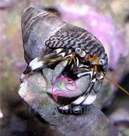Decorator Crab - Xenocarcinus species - Spider Decorator Crab

Decorator Crab is a great addition to your reef type marine aquarium. The ease of its maintenance popularizes it among all the levels of reef aquarists across the board. The camouflaging activity of Decorator Crab is an interesting process to watch out for. The way the crab is able to blend itself to its surroundings is really impressive. This article deals with the various dimensions of Decorator Crab with regards to its maintenance in a marine aquarium.
Taxonomy: Decorator Crab belongs to the Kingdom Animalia, Phylum Arthropoda, Class Crustacea, Order Decapoda and Genus Xenocarcinus.
Scientific names: The scientific name of Decorator Crab is Xenocarcinus species.
Other common names: Decorator Crab is also called as Spider Decorator Crab, Coral Crab and Conical Spider Crab.
Origin or natural range: The Xenocarcinus species is obtained from the Indo-West Pacific Ocean region including, Micronesia, Indonesia, Caribbean and Japan.
Size: Decorator Crab grows to a size of around four inches.
Color: The Xenocarcinus species occurs in irregularly striped colored patterns.
Compatibility: Decorator Crab is semi-aggressive towards the other marine aquarium invertebrates.
Habit & Habitat:
- The Xenocarcinus species is found on coastal reefs in its habitat.
- Decorator Crab shares a symbiotic relationship with gorgonians, hydroids and black corals, especially wire corals.
- The body of Decorator Crab is flat.
- The triangular carapace of the Xenocarcinus species is generally around 2.5 centimeters long and is pointed forward.
- The legs of Decorator Crab are long, spiny and resemble the shape of that of a spider. The long legs help the crab hold on to its host.
- The abdomen of the Xenocarcinus species is located at the bottom side of its body.
- The antennae of Decorator Crab are short and the rostrum is long, broad, shining and spiny.
- The Xenocarcinus species camouflages itself by attaching rocks, barnacles, coral polyps, anemones, seaweed pieces, sponges and bryozoans to the hooked bristles on the back of its shell. The camouflage helps Decorator Crab blend with its surroundings thereby saving it from its predators. Once the crab is grown up enough in size to defend itself, it ceases to camouflage.
- The Xenocarcinus species sheds its shell, called as molting, when the body of the crab outgrows it. In molting, the existing shell begins to loosen up as the new one begins to form below it. Eventually, the existing shell is shed even before the complete formation of the new one. For the period when Decorator Crab is without a shell, the crab absorbs water in its body and expands to a size quite larger than its original size.
- In order to dodge its predators, Decorator Crab leaves its discarded shell on a clearly visible site.
Temperature of water: Keep the temperature range of your reef tank maintained between Seventy-two and seventy-eight degrees Fahrenheit.
Specific gravity of water: The specific gravity of water in your marine aquarium should stand within 1.023 and 1.025.
pH of water: The pH value of water in your marine aquarium should scale between 8.10 and 8.40.
Feeding & Nutrition: Decorator Crab is Omnivorous in feeding habit and eats micro-algae, detritus and the meaty bits of seafood available on sand in your reef tank.
Care: Decorator Crab is easy to maintain owing to its non-poisonous nature.
Caution: The Xenocarcinus species may attack fish in case its dietary requirements are not met in your marine aquarium. Therefore, be attentive to your Decorator Crab’s dietary needs.

Blue Leg Hermit Crab - Phimochirus operculatus - Dwarf Blue Leg Hermit - Blue Hermit - Rock Hermit
Freshmarine: $2.50
You Save 83.32%
Before Placing Your Order
Store InformationShipping Info
Payment Info
Return Policy
Arrive Alive Guarantee
Adoptation Policy
After Placing Your Order
Track Your OrderSecurity Safe Shopping
Compatibility Chart
Shoppers Review










